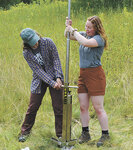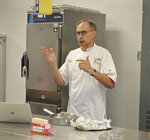DODGEVILLE, Wis. – Participants of the Grassland 2.0 Summit were presented with a variety of ways to connect with and learn from each other on soil health.
The summit took place at White Oak Savannah near Dodgeville.
“There are these existential crises that are facing us,” Randy Jackson said. “We have to keep pushing it forward and pushing it to the center of the conversation.”
Jackson is a professor at the University of Wisconsin-Madison and ecologist for Grassland 2.0.
Grassland 2.0 is a group of people from various backgrounds who collaborate to develop ways for producers to increase profitability, production stability, and nutrient and water efficiency. This is achieved through learning hubs and summits.
Jackson said one crisis that hinders the growth of grass-based farming is resource deprivation which is evident through flooding.
“Flooding that’s been exacerbated by the way we farm has caused entire communities to move their communities up slope rather than addressing the systemic problems that are happening in the soil,” Jackson said. “We’ve got this resource deprivation issue that’s confronting us every day. It’s real; it’s here.”
Addressing the soil issues at the summit were Ashley Becker and Mia Keady, graduate students at UW-Madison. Both women have spent time studying soil health and why soil carbon is important.
When conducting soil tests, Becker said the percentage of organic matter is an indicator of how much decomposing plant, animal tissues and microbes are in the soil. That number divided in half indicates a rough calculation of carbon in the soil.
Becker found that building up soil carbon has benefits both to the farmer and the general public.
“Farmers get better ability to adapt to floods and droughts with more soil carbon because water infiltrates more easily and you can hold on to more water and improve the productivity of your fields,” Becker said. “For the public, you get improved water quality and improved food production.”
Further research has revealed that pasture sites held on average 5.5 tons more carbon per acre on the top 6 inches of soil compared to row cropping sites.
A portion of time at the summit was spent in an activity that aimed to highlight others’ social positions and how people use that to make sense of biophysical landscapes.
This was achieved by walking to the top of a hill with John Strauser of Grassland 2.0 whose aim was to foster community conversations. At the top of the hill, participants could see a corn field, alfalfa fields and the venue which served as host of the summit. Participants were instructed to observe the different landscapes and take note of what they saw. Results had a wide variety of observations. Some people associated the corn with production, while others identified erosion among the crop. One participant, who happened to be a farmer, saw bare spots in the corn and associated it with decreased profit.
Strauser leads learning hubs with Grassland 2.0 and said these observations are what influence land use decisions people find to be socially acceptable. Different opinions on land lead to different uses of resources.
“These … can largely influence what people do on their landscapes and the way people manage their herd,” Strauser said.
The third part of the summit included a cooking demonstration with chef Jack Kaestner, instructor at Madison Area Technical College. Kaestner specializes in sustainability and local food.
He said grazed animals provide a more sustainable meat source.
“I always encourage people to go with grazed first,” Kaestner said. “It’s cheaper, and it is a more forgiving way to cook and use the whole animal.”
Kaestner said a lot of chefs only use tenderloin, ribeye or strip steak because they are known for their quality and tenderness. Kaestner likes to use shank because when cooked on a lower temperature for a longer period of time, it provides a better flavor and consistency for broth.
Kaestner said the key to cooking grass-fed meat is to back off on the seasonings, cook things slower and buy a good thermometer to aid in accuracy.
Hannah Kass led the final breakout session in zine making. Zines are self-published magazines which are usually made by people involved in grassroots or social movements. Zines became popular during the feminist movement and in underground subcultures.
Participants used existing magazines, glue, scissors and paper to construct their visions for grasslands on whatever scale was most relevant to them whether it was on their farm, back yard or community.
“Zines are a great way for social movements to communicate their beliefs,” Kass said. “It’s been a huge way for social movements to connect with each other and grow and expand.”
The Grassland 2.0 team plans to spend the next few years hosting listening sessions, conducting surveys and local conversations to learn from communities across the state and beyond to develop more ways to move toward grassland-based agricultural systems.



Comments
No comments on this item Please log in to comment by clicking here